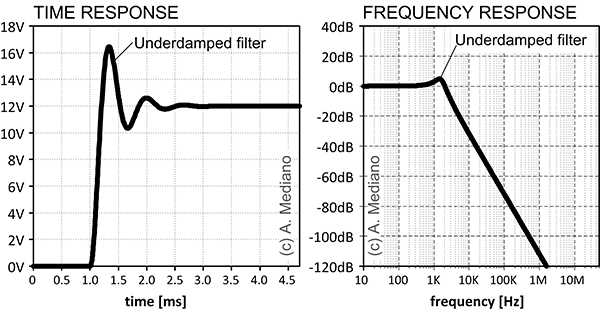Many EMI and SI problems are related with a combination of inductance and capacitance without losses. High peak voltages and currents, ringing, emissions, etc. are the result. Damping with resistors or ferrites are common solutions.
Many EMI and Signal Integrity problems are related with the existence of some resonance between inductance and capacitance without damping.
The ringing can create emissions, distortion, damage, etc. in electronic circuits and usually a solution for this problem is to include losses using resistors or ferrites.
One possibility for this problem is when using high quality components. High quality components can be characterized by low ESR (Equivalent Series Resistance) and high ESP (Equivalent Parallel Resistance)
Consider for example the situation in Figure 1. A PC board is being powered by a +12Vdc switching mode power supply and a Lo-Co low pass filter is used at the input of the board to obtain a clean supply system.

The designer is using a 100uH inductor and two parallel 47uF capacitors. The high quality components create a peak of voltage when PSU is turned ON. Note how peak voltage reach 17.3V in our circuit and one component was damaged sometimes during the operation.
The anomalous situation was analyzed using a single shoot scope trigger.
From a theoretical point of view a step voltage function is applied to the second order underdamped system and you can obtain up to Q times the input voltage where Q is the quality factor of the resonant circuit: more Q, more peak voltage.
The result for this peak (and ringing) could be damage in the powered circuits, EMI problems or unexpected behavior in power integrity.
That is because I am usually VERY careful when using high value and high quality inductors.
In Figure 2 a simple analysis of the filter is included both in time domain and frequency domain. The underdamped behavior is clearly identified in both time and frequency plots.

Typically, to solve the problem using the same Lo and Co values we can: 1) use lower quality capacitor (higher ESR); 2) use lower quality inductor (lower EPR inductor); 3) including some Rd damping resistor in series with Co or in parallel with Lo; and 4) including some ferrite in series with Co or Lo.
Solution 3) was analyzed with a 1ohm resistor in series with the parallel capacitors. The ringing disappears in the time and frequency domains (see Figure 3). Note the included resistor reduces the low pass effect between 10kHz and 1MHz because a series resistance with Co reduce the possibility for this component to offer a short circuit to ground in that frequency compared with the original situation.

My final advice: avoid high quality and high value combinations of inductors and capacitors without losses. If an underdamped situation is identified, add damping with resistors or ferrites.
 Arturo Mediano received his M.Sc. (1990) and his Ph. D. (1997) in Electrical Engineering from University of Zaragoza (Spain), where he has held a teaching professorship in EMI/EMC/RF/SI from 1992. From 1990, he has been involved in R&D projects in EMI/EMC/SI/RF fields for communications, industry and scientific/medical applications with a solid experience in training, consultancy and troubleshooting for companies in Spain, USA, Switzerland, France, UK, Italy, Belgium, Germany, Canada and The Netherlands. He is the founder of The HF-Magic Lab®, a specialized laboratory for design, diagnostic, troubleshooting, and training in the EMI/EMC/SI and RF fields at I3A (University of Zaragoza), and from 2011, he is instructor for Besser Associates (CA, USA) offering public and on site courses in EMI/EMC/SI/RF subjects through the USA, especially in Silicon Valley/San Francisco Bay Area. He is Senior Member of the IEEE, active member from 1999 (Chair 2013-2016) of the MTT-17 (HF/VHF/UHF) Technical Committee of the Microwave Theory and Techniques Society and member of the Electromagnetic Compatibility Society. Arturo can be reached at a.mediano@ieee.org. Web: www.cartoontronics.com.
Arturo Mediano received his M.Sc. (1990) and his Ph. D. (1997) in Electrical Engineering from University of Zaragoza (Spain), where he has held a teaching professorship in EMI/EMC/RF/SI from 1992. From 1990, he has been involved in R&D projects in EMI/EMC/SI/RF fields for communications, industry and scientific/medical applications with a solid experience in training, consultancy and troubleshooting for companies in Spain, USA, Switzerland, France, UK, Italy, Belgium, Germany, Canada and The Netherlands. He is the founder of The HF-Magic Lab®, a specialized laboratory for design, diagnostic, troubleshooting, and training in the EMI/EMC/SI and RF fields at I3A (University of Zaragoza), and from 2011, he is instructor for Besser Associates (CA, USA) offering public and on site courses in EMI/EMC/SI/RF subjects through the USA, especially in Silicon Valley/San Francisco Bay Area. He is Senior Member of the IEEE, active member from 1999 (Chair 2013-2016) of the MTT-17 (HF/VHF/UHF) Technical Committee of the Microwave Theory and Techniques Society and member of the Electromagnetic Compatibility Society. Arturo can be reached at a.mediano@ieee.org. Web: www.cartoontronics.com.

